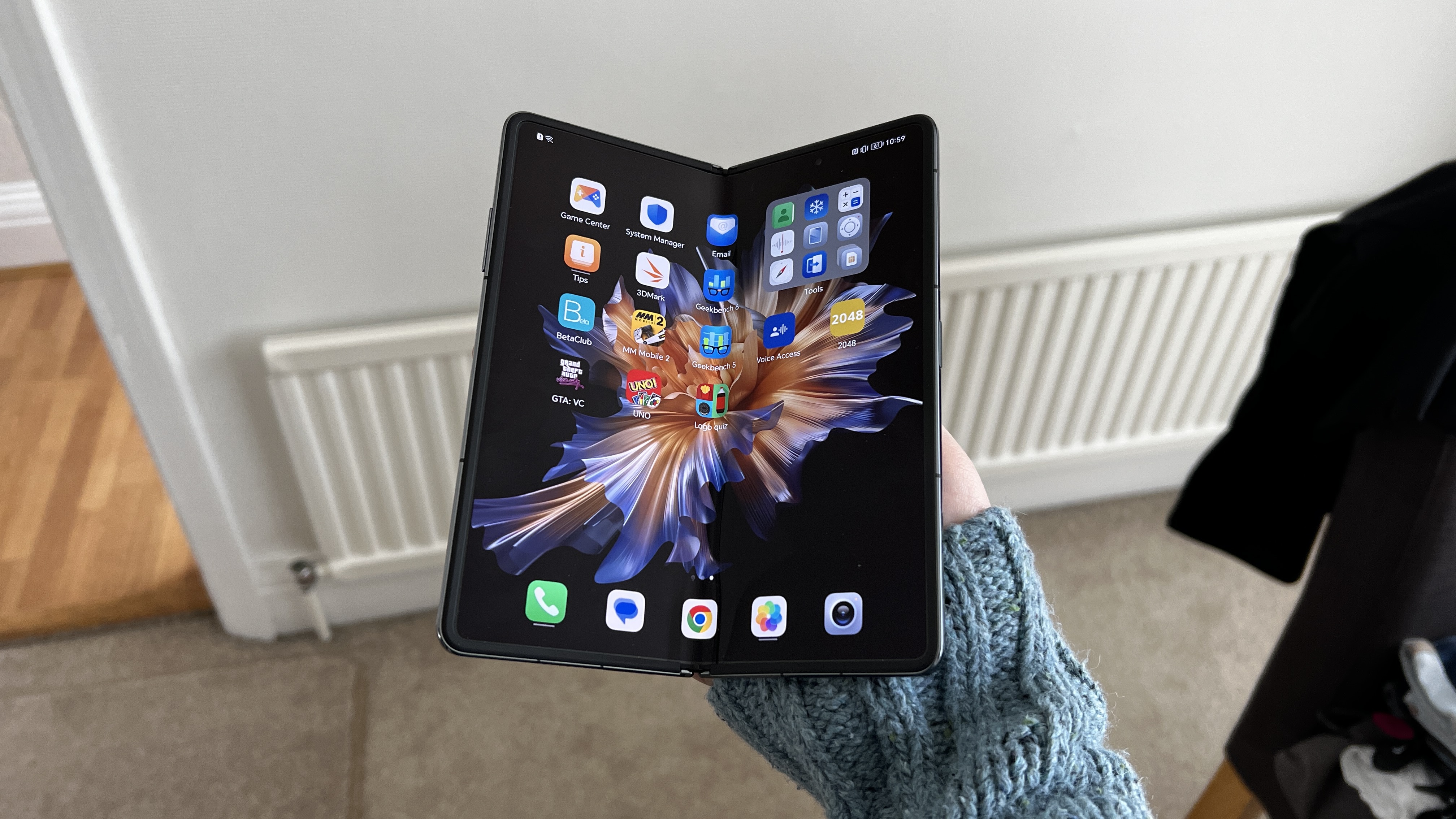Laptop Mag Verdict
The Honor Magic Vs has all the makings of a true combo breaker — an affordable foldable with premium stylings and enough performance to be an effective daily driver. There are some cutbacks like the lack of an IP rating to keep that cost down, but if you’re passionate about making the jump to a versatile form factor, these are easily forgiven.
Pros
- +
Premium design
- +
Gorgeous displays
- +
Solid camera system
- +
Surprisingly strong battery life
- +
Competitive price
Cons
- -
Very noticeable crease
- -
No IP rating
- -
No wireless charging
- -
Last year’s Snapdragon chipset
Why you can trust Laptop Mag
Foldables are a rich person’s game right now, which has created a huge opportunity for someone to swoop in and undercut the competition. That’s exactly what the Honor Magic Vs looks set to do on paper.
We say “on paper” because beyond going properly hands-on with the phone and knowing what it’s like (spoiler alert: it’s pretty damn good), that price bit is a little up in the air. We have no knowledge of cost in the U.K. and, since it’s Honor, chances are you won’t see a U.S. release.
So let’s break down what we know and answer the important questions here. Because to undercut the competition means some compromises had to be made. Is this phone still a premium beauty to use? Is it worth that investment with the cutbacks made? Let’s get into it.
Honor Magic Vs price and configurations
Like I said, pricing is a little vague right now. At first, we saw that the cost of the phone in China is 7,499 RMB (roughly translating to around £900). But now, following its MWC announcement, we know the price in Europe will be €1,599 (around £1,400).
That’s a bit of a jump in cost compared to the initial expectations made by its initial release, but it is worth noting this is still cheaper than the Samsung Galaxy Z Fold 4 (€1,799 / £1,649).
Honor Magic Vs design

One of my main gripes when looking at other foldables in the market is that they don’t look and feel like ordinary smartphones when folded up. This is actually a strength of the Honor Magic Vs with a thickness of just 0.5 inches.
Of course, this is still a little thicker than your traditional smartphone, but it’s thinner than the Galaxy Z Fold 4 (0.6 inches), and the subtle curvature of this premium design gives it a nice feel in the hand.
Sign up to receive The Snapshot, a free special dispatch from Laptop Mag, in your inbox.
Put simply, it feels very premium. This combination of glass and aluminum is luxurious from every angle, and I found that the flatter edge of the hinge is a great place to rest my thumb while using it. You’ll find the power button/fingerprint reader combo and volume rocker on the right.

Open it up and the party continues on the inside with a raised bezel around the edge and an impressively simple hinge system that conceals itself when folded out flat (the volume rocker moves over to the left with the top layer of this foldable sandwich.
The bigger display gives this an almost tablet-esque feel in the hand, with the lightweight nature of a smartphone (9.2 ounces). The equal distribution of weight across the Magic Vs really aids in making this a slick device to use in both positions.
Breaking down the other specifics, at 6.31 x 2.86 x 0.5 inches when folded (the width and thickness change to 5.57 x 0.2 inches), the Honor Magic Vs is ever-so-slightly taller and wider than the Samsung Galaxy Z Fold 4, but as you can see (6.1 x 2.85 x 0.6 inches, 9.28 ounces) it’s thinner and lighter.

So we’ve got an upmarket construction for a fantastic in-hand feel, but with quite the setback — there is no IP rating in here. We all know how sensitive to the elements foldables can be, and Samsung has worked hard to get to the point where the Fold 4 has IPX8 water resistance. If you do pick up this Honor foldable when it’s widely available in June/July, just be careful when using it out and about.
Honor Magic Vs display

Hitting the power button welcomes you to the gorgeous 6.45-inch OLED panel up front with a 1080 x 2560-pixel resolution, a 21:9 aspect ratio, 120Hz refresh rate, and HDR10+.
The 800-nit brightness isn’t quite as illuminating as you’d see from the likes of the Galaxy Z Fold 4 (870 nits on the front display and 905 nits on the inside panel). But it still is legible enough in direct sunlight, and the color reproduction has a vivid accuracy to it.

However, there is a real star of the show here in the form of the 7.9-inch foldable 1984 x 2272-pixel OLED display, also with a HDR10+, but with a 90Hz refresh rate instead. The difference is barely negligible to most eyes when watching your standard array of content, but the ultimate result of this squared off aspect ratio is a great display to get work done or play strategy-based games with a larger canvas.
Firing up the latest season of Drive to Survive on Netflix confirms just how much work Honor has put into this vivid, color-accurate display. Each effortless on-track overtake on circuits by day and night pop off the screen with immersive depth and vibrancy.
One thing worth noting is that the foldable crease down the middle of the larger display is pretty noticeable. Not an overt distraction, but you can feel it with your finger and any content down the middle does warp ever so slightly.
Honor Magic Vs audio

Let’s get the obvious out of the way — there’s no 3.5mm headphone jack, but you can solve that with a pair of the best wireless headphones.
As for the stereo speakers, they are as tinny as you’d expect from any phone, but the small tweeters on here do provide decent definition and clarity without distorting.
The Ghost Inside’s “Aftermath,” once again, sounds great on these small tweeters — a balanced audio profile with the ability to keep the thrashing power chords and guttural screams under control without any crackling at high volumes.
Honor Magic Vs performance
Inside the Honor Magic Vs, you’ll find a Snapdragon 8+ Gen 1 chipset, alongside up to 12GB of RAM and 512GB of UFS 3.1 storage. Of course, with an older chipset, you’re not going to see the same level of performance in the likes of the latest phones, as can be seen with the Geekbench 5 multi-core score of 3,863.
This is destroyed by the Snapdragon 8 Gen 2 For Galaxy in the S23 (4,876), and the iPhone 14’s A16 Bionic (4,553). But the phone does pip the Galaxy Z Fold 4 to the post (3,831).

As for graphics, since this current crop of phones are beginning to max out 3DMark’s WildLife test, we’ll have to go for the Extreme option that renders 4K graphics. The Magic Vs managed to hold its own with an average frame rate of 16.7 frames per second (FPS) — beating out the Galaxy Z Fold 4 (16.6 FPS) but falling short of the Galaxy S23 (23.03 FPS).
But while these are older specs, in real-world use, this is still a zippy phone, even under more CPU-intensive processes. Multitasking between Call Of Duty: Mobile, TikTok, Adobe Photoshop, and several other apps maintained that same speed and responsiveness without slowing down.
Honor Magic Vs battery Life & charging
We don’t have specific lab testing for this, but throughout my time using the Honor Magic Vs, I have to say I’m pretty impressed with the stamina of this foldable. My assumption was the larger display would drain that 5,000 mAh cell quicker, and while there is some truth to that, in reality it’s not as bad as I thought it would be.
In my normal day’s use including a few hours of web browsing, listening to podcasts and Spotify all day, plenty of social media use, photography, gaming, and watching YouTube videos in the evening, I still got through a whole day through to bedtime with 10% of the battery remaining.

That does mean you will have to charge it every night, which with 66W fast wired charging is a quick boost back up to 100% in around 35 minutes. The lack of wireless charging does remove some convenience of quickly juicing your phone, but all-in-all, you have a solid package here.
Plus, with just a 4,400 mAh battery in the Samsung Galaxy Z Fold 4, you can be safe in the knowledge that you will most likely get a little more stamina out of the Magic Vs. For reference, we did lab test the Fold 4, which got a total run time of seven hours and nine minutes.
Honor Magic Vs cameras

So, this is a tale of two halves. The rear camera system is solid, but the selfie shooters are a bit hit and miss. Let’s break it down.
Round the back, you’ll find a triple camera array formed of a 54MP sensor with f/1.9, a 50MP ultrawide with f/2.0, and an 8MP telephoto with an f/2.4 aperture.








That main shooter also comes armed with rapid dual autofocus, which ensures impressive levels of detail and clarity with a warmer focus on color science. If Samsung is your flavor of photography, this will be right up your street, and it even performs well in low-light conditions too.
The high megapixel count of the ultrawide makes this a very fun shooter to use — creating super crisp results with zero mushiness around the edges that you get from other lower quality lenses. And wrapping it up is an 8MP telephoto, which is fine in most cases but does create some noisier shots when the lighting conditions get challenging.

As for up front, the 16MP front-facing cameras (one on the outside, and one on the inside) are OK in perfect lighting conditions, but visual noise creeps in really quickly, night time photography is blurry no matter how still you stand, and you really should turn off those AI beautification features.
Video-wise, the ability to shoot up to 4K 60FPS with software-based image stabilization does a semi-decent job of recording smooth video. I’m never a fan of super vivid color science, so I know I’m coming in a little biased here. But this is more than good enough for shooting the occasional IG story and grabbing family video.
Honor Magic Vs MagicOS 7.1

Honor’s MagicOS 7.1, running atop Android 13, is clean, versatile, and dynamic across both displays. Unlike its parent company Huawei, Honor hasn’t been blacklisted by Google so you can access the Play Store.
Though that hasn’t stopped Honor making several convenient apps — some with a direct interaction on the home screen, such as swiping on the notes app icon to jot a quick few thoughts rather than going directly into the app.
And not only that, but Honor is committing to three major Android updates and five years of security updates. While the roughly 6+ years of iOS support you’ll find for the iPhone 14 is unmatched right now, this is a seriously impressive commitment.
Bottom Line

The foldable has always eluded me — both in price and in figuring out what the point of one is. But the Honor Magic Vs turned me around on the reason for getting one. This versatility to move between a smartphone and a tablet-esque experience in your pocket is something I truly fell in love with over the course of using this.
But not only that, this is a pretty good phone in and of itself. The battery life is surprisingly impressive, the camera system is solid, and while you may be on last gen’s Snapdragon platform, this is still a zippy phone.
Of course, there are drawbacks. The lack of any IP rating is sure to make you a little nervous using this thing in the rain, that display crease is very noticeable, and there is no wireless charging. But for the inevitably lower cost, this could be a worthwhile investment to those looking to jump into the foldable world.

Jason brought a decade of tech and gaming journalism experience to his role as a writer at Laptop Mag, and he is now the Managing Editor of Computing at Tom's Guide. He takes a particular interest in writing articles and creating videos about laptops, headphones and games. He has previously written for Kotaku, Stuff and BBC Science Focus. In his spare time, you'll find Jason looking for good dogs to pet or thinking about eating pizza if he isn't already.

